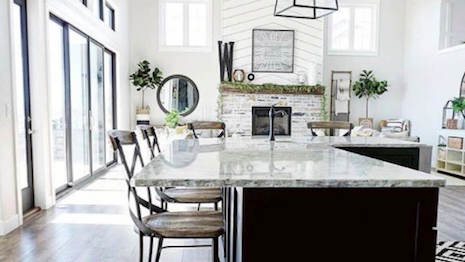Affluent and mass-market homeowners often have the same values when it comes to renovating their homes, but the difference lies in how they do so.
When it comes to renovation, all homeowners are focused on communal areas such as kitchens, bathrooms and outdoor areas. Luxury homeowners, however, are more interested in transforming a room by decorating with new furniture, accessories or window treatments.
"When it comes to their top priorities for their homes, these two groups have a lot more in common than you might think," said Amy Panos, home editor for Better Homes & Gardens at Meredith, Des Moines, Iowa. "Regardless of their income, homeowners care about creating an inviting home that has useful, upgraded spaces for family and friends to enjoy."
Luxury versus standard
Meredith’s shelter publications Better Homes and Gardens and Traditional Home have conducted the "Home Factor" survey that reveals the similarities and differences between the luxury and mass-market segments.
About 32 percent of affluent homebuyers will redecorate with new furniture and accessories, compared to only 14 percent of standard homebuyers, offering an interesting advantage to luxury home goods brands. Luxury homeowners interested in fixing up rooms with window treatments make up 23 percent of the survey, compared to only 18 percent of standard owners.
Luxury homeowners also differ in regards to sizing of their next home, with most looking for a smaller second residence, and a square footage reduction of 200 feet. But, at the same time, they are also looking for additional living spaces such as an extra bedroom, a home office and a master suite.
Most future homebuyers in both segments are looking for a separate laundry and an outside deck or patio, as well as an upgraded kitchen and bathroom.
Almost all homeowners have listed painting, changing flooring, bathroom remodels, decorating and kitchen remodels as the top five priorities. About 8 out of 10 survey respondents claimed they were thinking about making home improvements inside in the near future.
It is no surprise that 72 percent of high-end homeowners are ready to spend more for better goods and 78 percent of mass-market owners take more time looking for better deals.
Both groups are willing to take on some home projects themselves, but luxury owners are more likely to outsource these repairs than standard segments. Twenty-one percent of high-end owners will look for compensated help to do repairs, compared to 14 percent of others.
Additional insight
The number of homes sold for $1 million or more flattened in 2016, growing a mere 1 percent, according to other research from Christie’s International Real Estate.
According to the broker's Luxury Defined report, on average, sale prices for luxury residential properties rose only 2 percent, and homes spent 13 percent more time on the market than in 2015. Following economic and political uncertainties and fluctuations in 2016, the coming year in high-end real estate is looking up as consumers feel more confident (see more).
Despite a slightly weakened 2017, luxury housing in the United States is still booming, particularly in states such as Colorado and Hawaii.
According to a new report from realtor.com, growth in the sales of luxury homes in 2017 slowed compared to 2016, but the market remains strong overall with high demand. Luxury real estate dealers will have to be smart about selling houses in key markets and fast growing cities such as Seattle and San Francisco (see more).
"Affluent consumers may indicate they want fewer square feet in their next home, but at the same time they also want the private spaces, luxurious finishes, and all the bells and whistles within that smaller square footage," said Jill Waage, editor-in-chief of Traditional Home at Meredith, Des Moines, Iowa.
{"ct":"jV4pwobr2ZYBcdqOPcJZn\/u7ECjZpgat0R83SZ6jSnRkUnJbNLnQcTFfHkP+QDnxiAxImgg\/noIsAUN5l+z\/NlaAl1KIaM7zMHhwzebVyZdRyjfuXqLA3M2oUj3pZfVhflJsI7LCyS\/tpN6VODao6IoRmdFg0Pjtncs9JKQY2oDqf+3nqGXqU\/6Tw5yZN+TwBjwugS3pEPr3ejVpYkDvYii\/q23OJHNkU4r06H9kuVxXIoYzlI3RHvvOMDimUdbadyNk0Xw4xTGaHZPMlNx4b4XlRgsfMuMxO1h7+EVUBWGqLuvoqfg3lXR4nJ54c+eRYnnic7ZldxUSpXEehGblf7Sa6Amf8ylju3+qYY4efxq01HDSYmf26BM59F+AxYJb+t25lA0zCQ7n09o0sZ5llJohLLXBRRcFm3Pe2VvH6yb9kTSuHdGyr8QFTheFayQCsXdTNxEYnldjUv8JghViLerFWxb9iDTAw2cs4Y1A+FlQHMA7cpqD8vBqizdMlt+jrAW9txHCDTwHefm71vdZKli5ypR\/mCM\/q22DAmxqVTeQu2gWCM1aYck\/PyvshejNI8FMRqJUdZ7n+xf\/lcYWUeJHmStD7LUdkf2lELME36U+2YbL9gzZf82LZ4JDPL2HWRpnNplzD4Ob8ghUkPEwS464OUIFFxQiouRwmaNlT8kCX8h8a0dKGKH2egObr\/0zn0ISrRa5vo\/LLCY9r\/trGji+1bCU85JeCgyWAra17\/yi68M1Oqbyx1kuYvZ5s62mcaezpBulkfhiqymEDuMTs9WpfBBX3Sseqnm+PUEN7kMZksHthsq91iwhPipAdNDamejmgfYoNIuebncry4\/An3eIqKq8RrEb8Q1xv19mq8d5gcMAwUih1O5uF1AcCcz32jWvgOjPlCjODPwCDq\/uWA2pkfUZaLG\/GGrI6h19fNO8zK3VfB2vezQK103zUnh4ZHGJp78kMqKnFpLGV9LkhdFY1sI+DnrmV3twp\/AxmlvR0eYIbOYDyPw7MYfKhRzAbtKLFmlq5jsB3w5PQw6\/XQeqG6wONoSsmxTKFPhPJmbiZuPIP2m7U9uvdUHxNaRx1VVQ8fWMUZmxP1JoNZ47beFLFNT5zBaQXjv8LK+50b18OfwNe7vSGLI3lBO1hFZdCMfRT6rUq7cj\/5L5OrZ+Hwo5tVUjC2m9bohdXAgZtTDW5dmpvCoz4PwRXbgmk\/6setoeHblmC\/KZ0DG4UMWD+CbViIRrzrSbmmys+kbKyuCeHOmA5lSgeDRq1o0nXs22auvn\/BPc4YbXqtwpyq3TdhppCWth7D1tT\/dF9ehuSTepqclbOt4HKtgkyg9ClzPEZ7UCD3TJlD\/Q1jCLfSAifNHpueJS0923+YziwAdOe2O6QAL0pbc6LEvMo0AiV\/Wc+kjco9JYqLnIAKqM14u1cSqv9H7+TKGnSnMnd1I3s1wa2VBOm2PqwYBKYzJb2lMa28RJDMwAY\/M6I3HKUfHbiqrwxiW7yt0RAAkEJEzESpmYmssAtozy8wIXPbEnMNtBGChndsINUBJGYn3HOl6PfSiHgXRW3XO7aez4bgdxovzsm8poLvExHOR9NRmy3oqWVuQOiACcWe4gTrpY3hjwiLb9bC8OEJmCnK997aUDEcjrhu\/a+fEJrWKuXGn+IJnIuUDXnr\/E07RW8VFfxGj3OjWQRo55pJmlAx3ospiv9DF1+G5JG\/P8sGzQHc3dMAu+XniRxNalTEgeFNOLeYfWWpj55hMprydmeYcLr6bs35yv+6LqzkhbVPx6VSIxpZn8QNTzOl5zPaV70dJlzJy40sIRYxsz17kwAyoTKaiR3imMnEmcqtOEJMZUwwsB6ai07Q3sYgNnOdzaGqfS6ctly4jG0zL4nVQdf1uHFUVxvywkPEevFKXLTfLOp2IpuFSsTWoHNuGrHtjtoNDGQJOk1JAVceVKn1j2JZ9q3iInwOEx8P8UBBaORaYD7jIrtQvBjFr8UJ2WrPmhMtsJY+Hr22bteEqjfdz2FNwuD2MOTG9sZHiczJSz6vNsKrbi6gs6f0Jp78MjnkVpvUz\/lhdd58Dqsusl9\/pA8LJiv9aEhZOKsW4yfJBGlK4w1YZXQvgFMuiwV58nqk6AUBzeINNmlgb1o2ZM8liIrwKa2C+KPJL\/O3wnIOWOn1Rp6BtfXzMtMiZoGgjjkGDB4vZcd049WJn4om3yaU3cnMpi03+2X3qiPYPJsmw99v4gAhOZq1uaqndMwZG6j1TK79Fg1f2b502i+jvuXLUzFpOn1HUcKjLQ1uvSE3o384V8DutZnqJSmXkrbkL8L6jwlhn2qF\/3LsnYUYan7Ujs8QiT2fhLhu6PyiIDgM9vQhn6k\/sm+cdxxTIkEjv5kmwtUYw59EnXoInpeKIhgOTc8jGrJUf+NOQKg7YAc+rmpalaD2p6YyeUyAJkF17vM3do0b7fHRAZHBaT4HZODVTrUI6pmgxuvzgJhAKOviVqG0dWkkbQ4uPv8OdEHIzgwM95Lw+ZQz3kGGxJCOnpKusZCAq1jukvFFoQpwNhuIsRepe3NQxBouDFpIGJUE6ecvGF+YKRqzuenUyMbvLKh6k\/vl3zd8Am41ovj+0DfFZpHdClAAqYLUbUoraJybKrx7TZ2H5lWqS0wRwuAnyOdNBuM6tA+nmSwTAq8W0aHcWyaXqdruwfgC7zOSKIaxApTiC8AA59CE3mFZtpaHvcdDa0XAZDalKk3XS5ljVob+Jnv1LaxPIwxTFoYTkfO+puPZ2YHjG3JAnG9iQaY3fcOeGeI9vrfUEc2O2VorkSb0El1xjQghUL0UygoqkuMInza+spASzBEdnqofQHAsjJA9D7qxfer0mpqVeQvH1oPFTSBYgoFPyVvEgaiOmOvYvx28dRPiB8NOwgTDp2f5DsmunW6pvdD5FpfJUS\/TpKx+EenCVFLA8HTRwXMca0yQ9ItfNCN1AZHtkXRdJPgasWcHBagajKzrXcNl0\/6ncG2vrxtbJAr7fpUBcehdZyzjVWhP4xrZVr+mDvo7pp6Msd+97rKGIz5Jtw5UqaXG+1DMPlYkEWoe0jlmjLH+OOxfgJsfEaQ9+HuI7kLbK+0M2rhDLxwR1ekzLPjlHfNC2B1rWi33udDWh3HOP20aw\/9ae1\/HdrCZ\/CKS0nV60CdNB\/Tfd8AFQ4qLX6xfDcD+3gfP8+Ub3QVG4nRTyPWdk6LsBAH5SKruc+ml4dKggvf5hi6KAlMdgjA\/uGucFZTq2Wus2oqhF5T4c+jFkhINMYhdDUJb2JKjY2ft3RRIoYNPKQdkLXrN30OvQST3c24CywK30GXqZb3nAmYp\/sLS+AHNUO7YdXPrzVqcKhvKnQWXL9IqvhjQSb1WlbJ\/XpVk9tUyFnXd6Z08YUBHeJMdn2q3SqJWIXmO7ARhNDr1OHq5fLdjqhOl2S4AD9MuKpMO4aSrri2EbDHtUTVLl3LrldDlfTOT4qyGe5WbkhIT92gt6\/WO9QQzUBviYP66cmPBv+rVSkCXyBHZRs4rBFgRcAXsy+P\/dyYlqjjcIdpe5SLvNCAdE5gCiyPIlltCndYZNhKtz\/mn\/FVM3pqS4YkFHGJLAII1qQdYmz\/ukrOQHpTFburo703oiN5Prw5NR\/gMtQuOfLBgbI2IZ+PrHC\/Mq99W0usJslC1kcRtOSmjz3fz2aH\/fZZtDa48hJC3Ry53HkNldoU4HdANNJUIoyXGSfq28yd\/0JAjuVI3f5EI+GAkz3QOxbk6Px\/MVPLreAvg4uV1tOsDc2E+MBVITdQZoLM+QGuM+BQpkUu5nzYVohRQwLusjStZNxzX2e3\/7ygJafv0XmzREnyB+9B6HXZNFez5x3GAq6mzLGL6uJeDLDvfmn1D8lppakwbkJlS03XrGJLnjVNFkAorE0p\/Vew1Sb77ieZjM\/14Ihax3qZyLrcOXPYPAGzMk\/mAh3T1jGjaYzbnVN4OmuJRoHPCchdnYok30byTPlWyyNi4zGlyFETKQDWQIYBqehuCtRO2P5JElI+nL6Cf5wIVF7w7JXTc+m+swuiN07rVqq6KCvT1MBzPTEHAAGxBi392PdTm1xgsT5WavXgeV16Z0qTVmjAylncHR7nHZrP9fFZpj\/toTyvzFSwydhSqIRhkI4IOlFEG9UQtFuxKSMQ+m048oZv8QS6Izr5jfQrUUGHwJEB7ccz0VdnUcrEe\/KPuc89PqsX2cyi1c8HeWyPqAaSm77c4cQphYyTUUVdxBD25c4WdvOSgPXRC8hEpsa\/ZMKa07UOB+GCySnhfq9yEKOBNRxtWN9VuoxirmC2KOK8E0eGisZ2bsOW5SVwkiJ4+B0\/+cfXNxJif8uyNb0z+gpfMtDy9TvOI4uQlGOeXvLaH9N0PTVzsri+Pf\/jKwlVUk66EMh\/d\/M23I6uK5B9mfGQH5U4l7Kodd3FTkD8QBJOlpEQjEk2C1tALp1QPMiaoy2JKJv6cBnqu\/Vh\/muonEogX\/xK4mG9Ou5o3EHjW7dUUdS\/c\/0FV\/X+ugM5KDUQnPvb4kjpLFmQs8A4n\/G2W4FlwX7x6TpmuWE2IlNtbDoYmKqzhK2ZAQCA5q8HijkCxPNDQ1xUXQV1q\/qTMmG9YvfM9VDzigtf1Voe\/0yLmeojG8jDB91J\/+7Jr2shIGlVLmZa88gq1vHwsU6g0p2qpvLsDJw1Jdl\/cfYZhEikGfKxQYxOGhP1TKw4omUEQhxErkszRq9+kxvGpREHfR7KRVtsO3kkQhek7Xhkpzem2Ikn2x+S8OljfDpc7fydlki1fxzr0OXr5Ot\/2AMZhbFHhfAD8CLmCHWiuC\/7Y2sBjE3zgJkRvfbMHbVUqzA3b\/wluoqMJousLPoO\/iRCF4z1b1t6h\/uSFXy2cZIB7EnKIxeZm0aOeQVtEhqXlzoGN8oO+fzBhj79zimv44CjfA70n3RzHFJrrn3knYwumiLdxOEfV+85Hc8\/KhyQTlXJ5UgXEl8WTxFz0q2nBLsiMx65A3Cb1O2VTd1vWSyOLJJIeKaHsv6RRb5goMw6\/geoAosW+gTkMMdG1XNt1o\/W6guww8DLjP5iQnvcNo5fWO0\/X0M9eKbhjekG3JUmofZx8SWXupEd2S6g5kkLhPyVxGtXmJiFihEWbcBORDlCs9qwtyFtPi6O5SFHQwl4h9mw02+wYGXLoVGAzPSiPCkDgKLvasw0Skjfvj2xrN1QdhQVawZphrKHChLnmjK\/tJJyx0kQEewp8lutn1qgbMv48LrUusfF5z0DQYxDK5x85NWxIIl2Bopa3tuErgtqCGgfqbeViY\/G8KILREpMsgqD6GgmdwHbNkKM702xbUcSvCFezW4SlZWYxLGh2fxWwJihgOM3LY4YZy2+fzLppkY0LMU3WlNXBCq+UJbb73NO+PBNM3JAo20bi6\/woxOvqvjQiLDTjnfv5aa9FGGEe9BLz5hI45hgbFZO8LTEvbGESn+HqNLNzdVacBmRp\/ddo5YkGvei\/qkePgqFW8Ji7SzwfAHP7hWGn\/Q5fK4UQeS0d5B55lwuvUtInVZ0zZssNsAlsQZVsSpEroI2wRCRc1pzTDddh50BswFMyzP+DLDxE1ZDiTIrL0vHX4l3peAY99Eicw6QIzxiUGqvzpPm8ZHmMwCfd7SwW91kkFvt\/AwtfsuXzVLdrZpaoT9FeF+EtIICT1aUrvRk3cVi52QI0f39PM5m9vsKM03r83DIcWL8pLILSp8VVTymxH\/6Rt8IReuGslOdxRfRPitEhjlG6AhVVHVx8XPX\/zRW3KFXK4fIDTCghwbQJzf3Yrmm9Aa8f1iubwL3R\/8k4XVoD0AaHooBSraYu3AVyUNQhQtsFBe0U1VkA91Hh1SMHR2ZlqE5Jtg7fj0vpckIlQGa5wxZ7AZHFKc89c\/l7kbqy6TQxSHQKacc5iJXK5+L9EMHjYIQpv3dB\/7S9PihkHYHtP+FjE58uA3gFJWlsnd1yRkaWmApufoDulQBWL8Hrv5BAZ15oPK6wbOwhwGYAQ4HhmiUilWCLWDIdiVgJwS3wmBW\/2NI2DwMPChHwF0R8vWz6UMVMiHUUDJI3bswY7ccfilnNrqTDjtYtYVxtrrI0Va+8vg8Wdh5EHUKftljOWjBpnWwRJYHMoKF+A3woTO2nrQGxHw0R44PXx8ZCdbVeLdeRXC4DCmSEKsjhOcrY4VOTgNXz2tS39iu2KD+QMy79n7gUV2rT4ywfXVrB7uOBLf0EGH\/D3K4q\/u8xRwYGBZ5E9ARHJiBAZ4I1Wp1WqnZja3q1+SCkok\/FtoRqMUQs5zfamatV3vLEn7Xp0BL8MCus7C8nAn0taHHebUjJbkkY2jf0rBakDvKr\/PUsK38jz8kD2AJcO4OP5GAxZyJp8w0+mNBTPRI6TngalTwLBoo8dS2lKzgQYrs+WQMupT9S\/hBIPZn3W0PVlv1TB8\/Q7WQI\/EXKQez9C7Yll+7fPRShADqE90F7dsqHZiCrY0HJY6mpdk7K+NpmSDDJdi9mIJEMzl2+apBuFsexxMocPYuTQFJAteqomC8bL4gFQ7gxDCX+zPCqIL9qXVBfwl57KSbSmt0mQBS5lfPUvn8UsL5D7hWVZ7sT+KBBzkpdbJtpkruX+3vjpukcKMIdq23YU8Gemm7Qq53CWpNEH+4Di8KiZP9tIM3l2w9Nh1nTYhT1vMuaPD3yTUmKDYB746OqSvycliQVbR21Y1TUlcC2H+PA6A8R7pLXJhXc0+QckRlZEWZtoScEhhIY1A6pKroU8XUeKiLdhQvWU0XLuByLItXgsQJJXvZLxunZJLIDppkZhP2TII\/e7Obr2hY88XpNp7\/9r0TpfXYDh4CwCjAzjgAT2PUGm8aNPuk8JOhEcncS83RP3+V7qwwCrwegEuxpkTqow4zNNiHPoA28F\/XfM1vZZtEwBNX4cUAxodvsc3uXjx8h3qpK+3NUzNWALesabovKjUeYzv67SLHMDc5dDeqLTuJI7TQmfqAlHENsR8rHwXwxqEKp\/h5IqmZ63ntVMBlihq6NcPlHab2qXrRAeK+KoC9cazazgh8YXwlFduF1\/hn0CZbADAsEiMNz7VGDrTRs9lcMV0hgezggNhUCpV9+UvgKtpDq2mdGQ5G7R8odcRoo6YqiQ5rYarZQAcLhF3Hc1iJkZJh440DcrSMyT1O2bnxZB2P8FCFalgVpsxHz66GN3tDYYujjUjScdub4jVGfSqLlpRzcC6BF3xIU\/wZ1iHpTng0aw8m9lMrMewxeRtSxwqCk5YiH2p8NCb+KgX0CxzhEPfkbZJv1g3gBFcqjcEEWV0SW+lV14ItMcju0jakQPba9tbhz0h1j+hHe1+K4P6csBMi+R54oj7OqVYMzNdBtN4L2SjtJZoFkyxtwZF2BF1oaWm7vYWz7IK6CF8jToAxmu68jq3qO5DqdCQ65LpYHw+gSi9jndrA1sg+mL2zSlWlkPxEELlhkDqwD8CjNFTeu+dFRPS74mofsAT6n6ehX9RQhYxVDSS5v5ecYLZlK9OgISNs6GKy73PXGutzMnfUCXzBsL7y0PMsFtQWOIdzRgNxAYd7T5p9WwbHNk6s75XLoN0rhhEBTS++xv7yy0bVEO9JSDr46o7+8XYdlJaFN6ncCCqOHRwwtu+uZ9Sbu39D8M6m3El\/PAEC3Lab0Ae74J+vUDi+Vv7X8t4oalZip9bLVfsfdnrJ27BJk0elSMDCF\/F2WnY8horMf\/WxDj7\/38kMCQH0w7EpPjk1XgZPXty3vrEplSdbTziSrsd\/qF5wpWJLXXc0fHI6FXFtK5\/Brr7zowXFT\/13Wo5gFfV+65rYSvhBX7ILdTR7YIW7\/Ary5RiAp43ILwmIdyhC4+BcrhOag617ZxRcfPAImI4SXvNEz6ODdar2q+IYXWI24hcTuzfrKVDdpQKKkg9tiLf8Lsy9uZz1Y\/hF8kgX0Xe2c5YW9wxzqlAHXiSWYca0IhGAsVJefPu80nFbSvbzvf471ZKvZAcZEjnYbv5298BqZDsqJnd\/0zVEKwVsknhAGhDQfnIghRdrjIkV1s25EJazkcc0o5Qa0czUlsEdKjXzwJyxoHMLKSWz5l+6uSjIEpHRlB5Xl1xczBVbDng9YjcfYSmquQL15SjmXqtvAxcAXsVf1MD4rI+N8Mv47TBKt1apjHlUxEdBE8ibvC1bknHcOt93FNqNMqZ1fkiThw4wmw2BZcuGhjqqyOvBe3lvW1n3EoEJzmV0oRAQor0rywMCBoJsZ4JGhkuuVrGsRr+E3i2g4xYN9XBCOsSWqjC43uE5eWofMm2QvNWdLF+BN+jaNtevyvkSonSK\/cd4J3DJO0E7nEVmDt02LlqV+t9Hk27p8v+V4smK3Kr5JmAoopkNSJB20ShKB4A3tiWv1ts8BFmcvB7zM66SlSy7RpRwpMdgXJ3yBj93xdR7O+vnplbf\/zcXuK2JYpMSRkMHqO7zMWphiGT05CIMD0lvWKw8ucShowTo25KNaOtyUBQX8XasD4XrRJ+NgszN9S1sbYcm2DQ4VWm31HwMGXb0ifuzq4BA4+4bXSn96J2\/1awZdSJqEe4pBIduvkG+an73c2zlyg++HZLO7Lms+w7m4M0ds\/PK9hsI5jhcaixuXB5XH7dvHY+8YENN6dxkLmkc7tn\/ZXY\/C8nRkGEzokf69Kcur+ydM4Yu9JsSl4PME+tYFWPdGmt0Q6vQVUC2QRzdxF++HN7ScjOIMdbcjhN8JV7BfNyjpXHjCdIN8tTwPuhPSa8RN8WLPXV2fUWg61brx+4zJNXZPR0Ph+22xiF3ZUpGX8VvLRJI35Nu+24tVAjR7NHsZC4pR1f9V7gU34pj7RDpN4d+n\/pa6eZuf02BcspjZN6F514tLDmx\/kSpFV\/hBxP9gQT2\/ZyqEUE81BVbflDm8RXkj\/hRMX95pK3hcZVB62VkCH+wxV33MC\/iD1pTMcy1pXRihqY3ymKUmb2kXCIOqQ+nhEkYcCSYE2PF1SDmx+miv9F8EWrFPrTRCSVwa8yRuS9FJHh5EAL66uZcxgaOyUS5KZQLivCuBcQONlBIEpWnh68wIaIYycJ\/oR94gGrk6EGMleE9JPWNPawR9i4CYonoZpIzkutWUjBy+joDnKco0qkA8M\/uiZFwRv4sJNNWHIFH92sCivBp2lUnS4ypOrh4d4WIIPWTq++QX+jr93PMSZw4dUfJ8\/RsScOKEAp9opUeS1LLr16jo+DQnePievP18gZ\/hQ9khL5NbUteXk7dQsoZfzQpz+xM2EdwaXp5aJU7DtTLZfy1Gr3XsrKWm8h461\/UtH\/qRaiy+iIvilvHydqrUH+p+bRZg==","iv":"f8964cdd161f8004775ce00d8d3838ad","s":"b6e5abc46994ff92"}

 Homeowners are mostly interested in upgrading their kitchens. Image credit: Better Homes and Gardens.
Homeowners are mostly interested in upgrading their kitchens. Image credit: Better Homes and Gardens.